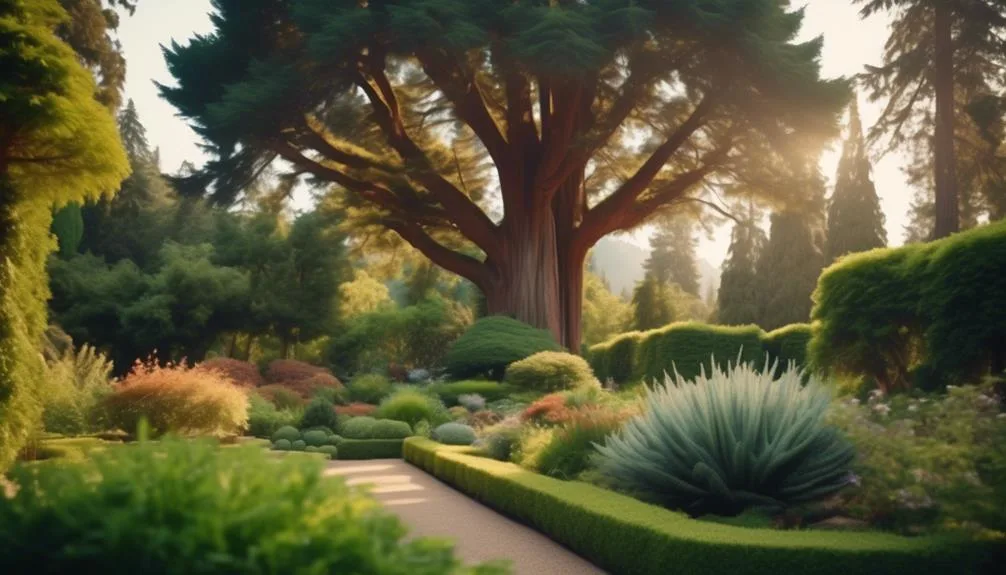Creating a stunning redwood tree feature in your garden can elevate its appeal and provide a tranquil atmosphere. Choosing the right tree, planting it strategically, and giving proper care can bring the grandeur of these iconic trees to your own backyard.
Imagine the beauty and serenity it could add. But how can you achieve this? Stay tuned to discover the simple steps to create this picturesque focal point and transform your outdoor space into an awe-inspiring sanctuary.
Selecting the Right Redwood Tree
When selecting the right redwood tree for your garden, consider the specific space and climate requirements of the species to ensure optimal growth and health. Redwood trees have varying soil requirements, with some species thriving in well-draining, acidic soils, while others prefer loamy or sandy soils.
Additionally, it's crucial to factor in the tree size, as some redwood species can grow to towering heights, making them suitable for spacious gardens, while others are more compact and suitable for smaller areas.
Climate considerations are also important, as redwood trees have specific temperature and moisture needs.
Understanding the tree's lifespan is essential, as some redwood species can live for thousands of years, while others have a shorter lifespan.
Planting and Positioning the Tree
To ensure successful growth and development, carefully consider the optimal planting location and positioning for your selected redwood tree in your garden. Here's what you need to do:
- Soil Preparation and Watering:
- Choose a well-draining soil and amend it with organic matter to provide the tree with essential nutrients.
- Water the tree deeply and regularly, especially during the first year after planting, to help establish a healthy root system.
- Sunlight Exposure and Spacing:
- Select a planting site that receives full sunlight for at least six hours a day to promote vigorous growth.
- Ensure proper spacing between redwood trees, allowing enough room for the tree to reach its full potential without overcrowding.
Providing Proper Care and Maintenance
Proper care and maintenance of your redwood tree involves regular inspection and pruning to ensure its health and longevity. When pruning, focus on removing dead or diseased branches and shaping the tree to promote optimal growth. Use clean, sharp tools to make precise cuts and avoid damaging the tree. Additionally, maintaining the soil nutrition is vital for the tree's well-being. Consider using a balanced fertilizer to provide essential nutrients and improve the soil structure. Here's a simple guide to pruning techniques and soil nutrition to help you keep your redwood tree thriving:
| Pruning Techniques | Soil Nutrition |
|---|---|
| Remove dead or diseased branches | Use balanced fertilizer |
| Shape the tree for optimal growth | Improve soil structure |
| Use clean, sharp tools for precise cuts | Provide essential nutrients |
| Avoid damaging the tree | Maintain soil health |
Focusing on these aspects will contribute to the overall health and beauty of your redwood tree.
Enhancing the Tree's Surroundings
Enhance the beauty of your redwood tree by carefully selecting complementary plants and incorporating natural elements into its surroundings. Consider these landscaping ideas to elevate the aesthetic appeal and provide environmental benefits for a thriving wildlife habitat:
- Understory Plants: Choose shade-tolerant plants like ferns, hostas, or coral bells to create a lush and diverse understory beneath the redwood tree.
- Mulch and Rocks: Use organic mulch to retain moisture and suppress weeds, while strategically placing rocks or boulders to add texture and contrast to the tree's base.
- Bird Feeders and Baths: Attract a variety of birds by hanging feeders and installing birdbaths to encourage wildlife activity and create a harmonious ecosystem around your majestic redwood tree.
Preserving the Redwood Tree's Health
Develop a proactive care plan to ensure the continued vitality of your redwood tree. Regular tree trimming is essential to maintain its health and shape. Prune dead or diseased branches to prevent decay and promote new growth. Additionally, monitor the soil quality around the tree. Redwoods prefer well-draining, slightly acidic soil. Test the soil pH and make necessary amendments to create optimal growing conditions. Here's a helpful table to guide you on preserving your redwood tree's health:
| Care Task | Frequency | Best Time |
|---|---|---|
| Tree Trimming | Every 3-5 years | Late winter or early spring |
| Soil Quality Check | Annually | Before the start of the growing season |
| Soil pH Testing | Every 2-3 years | During the dormant season or early spring |
| Soil Amendments | As needed | Before the growing season or after soil testing |
| Mulching | Annually | Early spring or late fall |
Conclusion
In nurturing your redwood tree, you've not only cultivated a breathtaking garden feature but also a lasting legacy. With the right care and attention, your redwood can stand as a symbol of resilience and natural beauty for years to come.
How will your redwood inspire future generations to cherish and protect our natural wonders?
Mark Hoffman is a dedicated arborist and tree care specialist with over a decade of experience. His love for trees began when he visited Yosemite National Park as a teenager and was awestruck by the giant sequoias. Mark pursued his passion by studying forestry at Michigan Technological University, where he earned a Bachelor of Science degree.
Since then, he has worked tirelessly in the field of arboriculture, helping to preserve and protect trees in his community. His expertise and dedication have made him a respected leader in the industry and a valuable resource for anyone seeking advice on tree care.
